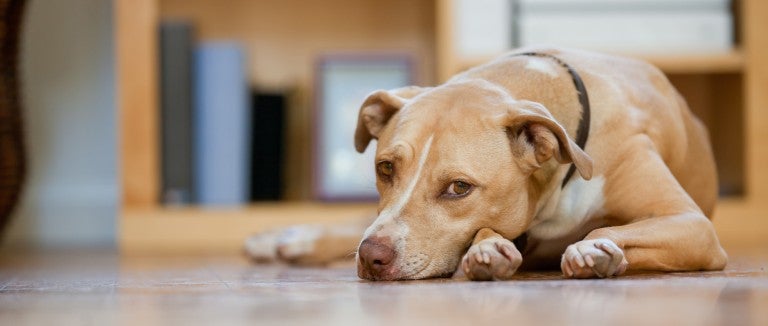Is my dog’s nose supposed to be wet? (Yes, but not dripping.) What color are healthy dog gums? (Pale pink, but not red.) At-home exams are no substitute for regular veterinary visits, but they can help make you aware of any health issues as they arise. To catch infections, injuries and illnesses before they progress, regularly take note of any changes in your dog’s behavior and conduct this easy nose-to-tail exam.
At-home dog health exam
Skin
Feel for any lumps, scratches, scabs or swelling. Dandruff and oily or missing fur can indicate skin or internal problems. Part the fur to look for fleas; specks that look like black pepper are actually "flea dirt" (flea feces that contain your pet's blood and turn red when wet). Keep an eye on any lumps, especially if they appear after a vaccination.
Ears
Check for flaking, scabs, foul odor, excess wax or discharge, which could indicate an ear infection. If you see a black, gritty substance inside, your dog probably has ear mites, which are parasites that cause severe itching and are contagious to other pets.
Eyes
Look for bright, clear, evenly focused eyes. One of the most common eye ailments is conjunctivitis, when the pink membrane that surrounds the eye and the lining of the eyelids becomes inflamed. One or both eyes may be affected. If you see redness, discoloration or discharge, you might want to call a veterinarian.
Download Conjunctivitis Fact Sheet
Mouth
Your dog’s breath should smell neutral and their gums should be pale pink. It’s not normal for a dog to have (very) bad breath, red gums or brown streaks on their gums or teeth. If you see these issues, your dog may have cracked or infected teeth‚ or even a piece of a treat or stick stuck in their hard palate.
Nose
Your dog’s nose should be clean and free of excess mucous or discharge, which could indicate a respiratory infection. It may be warm or cold and it may be wet or dry. All are normal, but dryness coupled with flaking, cracking or redness may indicate dehydration or sunburn.
Tail
Look under the tail. If you see what looks like grains of rice or spaghetti, you are looking at signs of parasites, which can spread to you or other pets. Parasites will require medication from your vet.
Feet
Look for torn or overlong nails, cuts, swellings or infections. Overlong nails will curl over and/or click against the floor as your dog walks; regularly trimming your dog’s nails to approximately 2mm away from the quick will keep them comfortable and prevent injury.
If you discover a potential health issue, don’t rely on the internet to tell you what to do; many ailments have similar symptoms but will require different treatments, and many human medications are toxic to pets. (The few medications that can be shared will require a different dosage.) If you’re unsure if a symptom requires a vet visit, call your vet’s office and describe it.
Sign up to receive our exclusive e-book full of important information about caring for your pet, including training techniques and answers to frequently asked questions.

How to keep your dog healthy
Make routine veterinary visits
“Maintaining a good ongoing relationship with a veterinarian is the best way to keep pets healthy and happy,” says veterinarian Melissa Shapiro. “Many times, we’re able to detect underlying, slowly progressive illnesses that, when diagnosed and treated early on, have a better long-term outcome and tend to cost less to treat.”
If you’re leery of the potential veterinary costs, Shapiro notes that veterinarians are often willing to help clients choose among treatment protocols that range from simple and budget-friendly to more involved and expensive. Plus, the blow to your wallet might not be as bad as you imagine: A fecal or urine analysis typically costs around $35 and eardrops usually cost less than $30.
Pay attention to any changes in your dog’s behavior
Seemingly benign symptoms like butt scooting, head shaking, pawing at ears or eyes, drooling and increased water intake, among others, can indicate that there’s a medical issue. For example, if your dog looks like they’re riding a magic carpet, they might have feces stuck to their skin or fur, or they might be trying to empty their anal glands. “Having the dog’s anal glands checked regularly may help avoid the dog ending up with an anal gland impaction and abscess, which is very painful and costly to treat,” says Shapiro.
Groom your dog regularly
Be sure to brush your dog’s fur and teeth and trim their nails. Fur brushing is good for removing loose fur and debris caught in the fur, distributing oils and stimulating blood flow; long-haired dogs will need fur brushing and trims to avoid painful matting. Brushing your dog’s teeth on a regular basis will help prevent or delay dental issues (many dogs, particularly small dogs with crowded teeth, are prone to dental issues.) Trimming your dog’s nails will help them walk comfortably and will prevent their nails from getting torn off, which can bleed profusely and may require a vet visit.
Be prepared
Put together a disaster kit and a first-aid kit for your dog. A pet first aid kit includes a book on pet first aid, gauze, nonstick tape, pet shampoo, tweezers, antibiotic ointment, styptic powder (for small wounds) and activated charcoal (for poison exposure.) Many pet supply retailers sell pet first aid kits.

